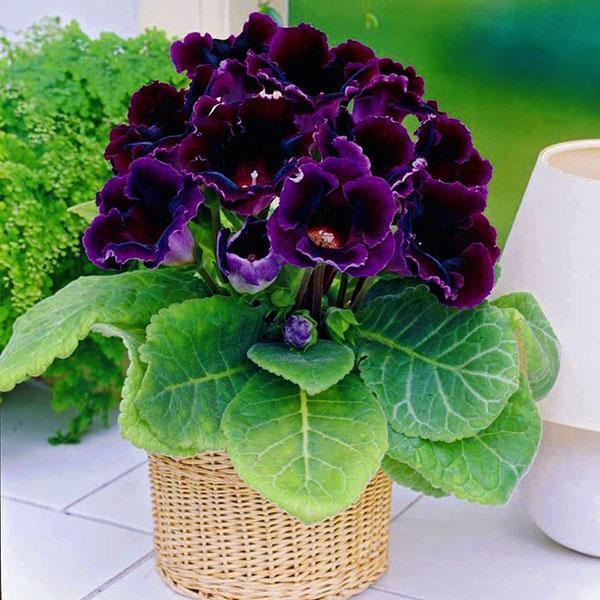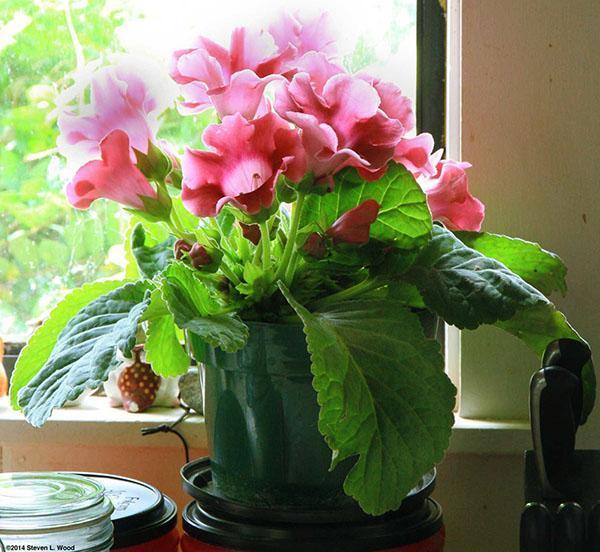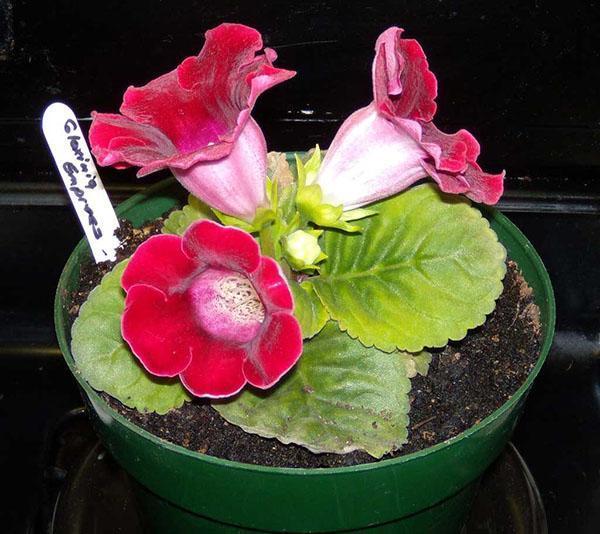Learning to care for gloxinia at home
 Velvet leaves and large bell flowers of gloxinia are loved by many growers. And with the current abundance of varieties and hybrids, it is doubly offensive when, due to mistakes or lack of care at home, gloxinia blooms little and irregularly, and sometimes just dies.
Velvet leaves and large bell flowers of gloxinia are loved by many growers. And with the current abundance of varieties and hybrids, it is doubly offensive when, due to mistakes or lack of care at home, gloxinia blooms little and irregularly, and sometimes just dies.
How to succeed in growing with a home plant? How to care for gloxinia at home, so that the culture stably pleases the grower with powerful foliage and lush caps of bright colors?
Lighting conditions for growing and caring for gloxinia
Like all members of the family, domestic gloxinia loves an abundance of light, but direct sunlight does not have the best effect on the condition of the plant. Quite dense pubescent moldings can wither, flowers wither much ahead of time. Therefore, caring for gloxinia, they choose a place for it according to the season and climatic zone.

At the same time, we must not forget that a lack of light when caring for gloxinia threatens:
- stretching internodes;
- loss of decorative foliage;
- a decrease in the quality of flowering or a complete rejection of the formation of buds;
- pallor of foliage and blooming flowers.
To make the plant comfortable in the created conditions, it is provided with 12-14 hours of daylight.
It is especially important to observe this rule during the period when the tuber has just rooted, and leaves appear above the surface of the substrate. backlight lamps.
Read also the article: streptocarpus - care and cultivation video!
Microclimate for the care and cultivation of gloxinia
 Tuber rooting takes place at a temperature of 24-25 ° C. When gloxinia forms the first leaves, the temperature is lowered to 22 ° C during the day.
Tuber rooting takes place at a temperature of 24-25 ° C. When gloxinia forms the first leaves, the temperature is lowered to 22 ° C during the day.
Night air can be up to 4–5 ° C cooler. If the room is hotter, and the plant lacks light, which often happens when the buds are set at the end of winter, even with proper care, gloxinia stretches, losing some of its decorative effect, flowers and leaves on long petioles become smaller.
The lower temperature limit for gloxinia is 18 ° C. In colder air, the plant slows down the growing season, and if you do not adjust the care of gloxinia at home in time, it can die. A prolonged temperature rise above 28 ° C is just as detrimental to the plant during the growing season and flowering.
In addition to the temperature regime in the room, gloxinia is important for air humidity in the range of 60-80%. Discomfort associated with excessive dryness of the air is indicated by folded down, slightly tucked leaf plates.
 How to care for gloxinia if the room is heated and the air humidity is much lower than the recommended values? The pubescent leaves of the plant do not tolerate spraying, often used to humidify the air. Therefore, in this case, it is better to put the pots of plants on wet expanded clay or use household humidifiers.
How to care for gloxinia if the room is heated and the air humidity is much lower than the recommended values? The pubescent leaves of the plant do not tolerate spraying, often used to humidify the air. Therefore, in this case, it is better to put the pots of plants on wet expanded clay or use household humidifiers.
If irrigation of the crown is necessary, it is better to do it in the bathroom at night, so that in a closed dark room the leaves dry out and the gloxinia gets completely dry on the window.
Planting and caring for a gloxinia tuber
Depending on the storage conditions, the gloxinia tuber starts growing from February to March. At this time, it is important:
- get it out of last year's substrate, clean it from the remnants of old roots and soil;
- for half an hour, hold with a slightly pink solution of potassium permanganate or treat with any available systemic fungicide;
- immerse in a solution of heteroauxin or other growth stimulant for 12-24 hours so that the growth point in the recess is not exposed to the drug.
 Most often, it is at the planting stage and during the subsequent, as in the photo, caring for gloxinia at home, the greatest risk of losing tubers appears. This happens due to their decay. Therefore, in the pot, drainage must be done with a thickness of at least 3-4 cm, and the tuber itself is sprinkled with soil no more than a centimeter.
Most often, it is at the planting stage and during the subsequent, as in the photo, caring for gloxinia at home, the greatest risk of losing tubers appears. This happens due to their decay. Therefore, in the pot, drainage must be done with a thickness of at least 3-4 cm, and the tuber itself is sprinkled with soil no more than a centimeter.
The gloxinia pot is chosen depending on the size of the tuber. A container with a diameter of 7-9 cm is suitable for a young specimen, and a long-blooming tuber is planted in a pot up to 15 cm wide.
As a substrate, you can recommend a mixture of two parts of leafy earth, the same amount peat and one share of washed sand. It is useful to sterilize the soil, as well as add a natural antiseptic to it, for example, a little crushed coal or sphagnum.
The planted tuber is covered with a film or bag and placed in a warm place in a well-lit place. In such a shelter, the plant remains for several days, during which, in addition to regular airing, special care for gloxinia at home is not required.
Watering regime for caring for gloxinia at home
Watering when caring for gloxinia and growing it from a tuber is best done through a pan or along the very edge of the pot.
It is extremely dangerous if moisture gets on the core of the tuber, or on young, fragile foliage. The sun can cause permanent burns, and the cool air combined with water leads to pockets of rot.
 Water for irrigation should be separated and 2-3 ° C warmer than indoor air. When the moisture is absorbed into the soil, after half an hour, its remnants are removed from the pan under the pot.
Water for irrigation should be separated and 2-3 ° C warmer than indoor air. When the moisture is absorbed into the soil, after half an hour, its remnants are removed from the pan under the pot.
The interval between watering is selected in such a way that during the passing time the clod of soil is almost dried out. At the same time, with a cold snap or a long period of rains, it is much less common to moisten the substrate when caring for a gloxinia flower at home.
Top dressing when caring for gloxinia
Rapid foliage growth and lush bloom are impossible without additional support. Gloxinia is alternately fed with organic and mineral fertilizers... It is best to carry out this procedure in the evening or during the day, as well as in cloudy weather, so that the sun does not damage the growth zone and foliage of the plant.
 Before the appearance of buds, in addition to organic matter, the plant needs nitrogen, which stimulates the growth of green mass. But after the formation of buds, the ingress of nitrogen into the soil is limited and they switch to phosphorus-potassium fertilizing. They enhance flowering, and trace elements help maintain a high decorative effect of plants.
Before the appearance of buds, in addition to organic matter, the plant needs nitrogen, which stimulates the growth of green mass. But after the formation of buds, the ingress of nitrogen into the soil is limited and they switch to phosphorus-potassium fertilizing. They enhance flowering, and trace elements help maintain a high decorative effect of plants.
When the mass flowering is complete, as part of the regular care of gloxinia, after two weeks, fertilize it with a potassium-phosphorus agent twice. This measure will help the tuber prepare for hibernation.
Gloxinia care during rest
 The end of the growing season of gloxinia falls in mid-autumn.
The end of the growing season of gloxinia falls in mid-autumn.
When the aerial part dies off, the tuber gradually goes into a state of "hibernation", ceasing to develop and consume moisture. At this time, it is important to first reduce and then completely stop watering.
For the entire rest period, as in the photo, the care of gloxinia at home is changing. First of all, it is important to ensure safe storage of the tuber. This is done in one of two ways:
- the pot is transferred to a cool room, where the air is no warmer than 10–15 ° C, and is sometimes humidified to prevent the tubers from drying out;
- after the foliage dies off, the tubers are removed from the soil, cleaned and sprinkled with sand or sawdust and placed in the cold.
In the second case, the storage temperature of gloxinia tubers is 5–8 ° C, and the substrate in which they are located must be dry or barely damp, otherwise rot and mold cannot be avoided. This storage method is convenient in that the planting material does not take up much space, and caring for gloxinia is reduced to examining dormant tubers.
That with gloxin flowers wither and buds turn black? Thank.
Blackening and wilting of buds occurs as a result of lack of nutrition or high soil moisture. Judging by the photo, your gloxinia has problems not only with the buds - the petioles rot on the lower leaves. I would check the root to see if the tuber itself is rotting. In any case, gloxinia needs to be transplanted and treated with fungicides. It is better to remove the affected parts.
What to do if gloxinia began to grow ahead of time? Can the plant be cut again?
What do you mean by the words "ahead of time"? The period from February to March is exactly the time when gloxinia wake up from hibernation. And there is no need to cut them off when they retire - the aerial part of the plant itself should wither when the frequency of watering is reduced, and only then the remnants of dry foliage are carefully removed.
They got it late and the shoots are stretched out; do I need to cut them?
It seems to me that in March it is already too late to cut off the shoots. You can try two options: either pinch off the top, leaving the leaves closest to the ground, or transplant the tuber, filling the elongated stem to half. By the way, the cut off top can be rooted.
Good day! There are some spots on the leaves, what should I do? I cut off two leaves, because the spots are becoming large and the leaves are dying. Now spots have gone all over the flower, all the leaves (((
It is not very clear without a photo, but most likely it is a fungal disease. Pruning will not help, you need fungicides and transplanting into fresh substrate.
And which fungicides are better to take? She was pretty and suddenly it started. And the leaves are curling and the spots are silvery. Unfortunately, I can't upload a photo (Thank you for your answer!
Please tell me, it's the end of August now, I have rooted the leaves, there are rosettes of young foliage. Old leaves are starting to wither, I will remove them. And what to do with young people? How to leave them in the winter? How to care? Thank.
Since winter is ahead, gloxinia should rest at this time of year. From mid-autumn, when growth stops, the pots with young plants need to be rearranged in a dark place and gradually begin to reduce watering. In the spring, you bring them back to light and warmth and take care of them like an adult gloxinia.
On August 23, I decided to look at the pots in a dark, cool place, and there are sprouts. She put it on the windowsill and poured it. What will happen?
Perhaps your gloxinia will have time to bloom before winter. This is a natural awakening and cannot be slowed down.
I have my first gloxinha. In the summer, I picked up a lot of buds, but it never bloomed in September, everything dried up. Yesterday I removed the dried top, and under it a young shoot 7-8mm. Stands on the windowsill. What to do with it next?
Most likely, something was not enough for her to bloom, maybe food. Therefore, in the fall, the plant, according to its schedule, went into hibernation, to gain strength. Why did it end so early - who knows? Green pets often come with surprises. Since the flower has decided that it is time to wake up, give it that opportunity and take care of it as usual. This is described in the article above. This time, when buds appear (if they are, of course, because gloxinia has not really rested), feed.
In the summer, they put two large leaves of the head in a glass of water. Now is November, one leaf has given roots and it seems
a small nodule formed. The leaf itself dies off. Advise, what's next?
Did I understand correctly that you rooted the leaf in the water? In such cases, decay is a common problem; it is better to root it directly into the soil. In any case, try planting a leaf in the ground - if there are already roots there, then it's high time to do it. If it dies, this may be the norm: when a tuber and young leaves appear, the old plate either withers by itself, or it is cut off if it prevents the “new generation” from growing. In addition, do not forget that it is autumn now - the time when gloxinia retires. Plant a leaf, arrange a greenhouse and observe it. If the young tuber continues to grow and form a new rosette, continue tending the plant as usual, but with moderate watering. If there is no growth, send him to rest in a cool place. In case of successful rooting during the winter, the young gloxinia will gain strength and begin to actively grow in the spring.
Hello, a friend gave her gloxinia, which woke up at the end of February, now she has grown well, she has two sprouts growing from a tuber, is this how it should be? Or should there be one sprout?
You will have a lovely lush bush.
Then let both grow))) in another place they advised to pinch off one, or cut the tuber, but I feel sorry for ((
My three gloxinias are many years old. Three large "washer" tubers formed. Do I need to do something with them?
If the tubers are blooming, you don't need to do anything. It is believed that the larger the tuber, the larger the flowers will be. But if you want to propagate your gloxinia, and at the same time they do not form young nodules, but there is only an old one, it can be divided. Cut the tuber into two or three parts, treat the cuts with brilliant green and plant these cuttings in light soil. Do not overfill - this method of propagation is good, as it allows you to get new plants in a short time. But on the other hand, and very risky - it is easy to overmoisten the soil, and then the fragments of tubers can rot.